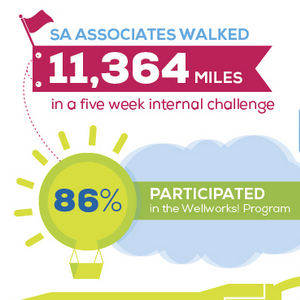
Creating a Culture of Wellness in the Workplace
Most people understand the benefits of choosing a healthy lifestyle, but the correlation between wellness and work performance may be overlooked. The Wellness Council of America says that 70% of workers cite job stress as a cause for frequent health problems. What’s more, a growing collection of research shows that healthier individuals take less leave due to illness, use their health care benefits less, and report higher levels of productivity, engagement and morale.
Effective corporate wellness programs must promote healthy lifestyle behaviors while also mitigating the harmful effects of workplace-related stressors. In the past few years, SA has developed and grown its wellness initiative, called WellWorks!, as part of its ongoing commitment to help associates make positive choices.
After committing to a wellness strategy, a committee was formed of team members from every department who have a strong interest in health and wellness. Through research and an associate survey, the committee developed a program, including a financial wellness benefit, which focuses on four key pillars of wellness: nutrition, physical activity, lifestyle/behavior change and work-life balance.
The program includes:
- Free, onsite health assessments and biometric screenings
- Wellness challenges and activities
- A speaker series covering topics ranging from nutrition and exercise to stress management and relaxation techniques.
- Onsite yoga classes
- Onsite massage therapy
- Incentives for choosing healthy behaviors like exercising, good nutrition, and not smoking.
- Healthy snacks bowl available in the break room
So far, 86% of SA associates have participated in SA’s wellness programming; and about 82% of program participants report that they’ve incorporated healthy changes in their lives as a result of these initiatives.
How can you get started within your organization?
- Make the commitment! Senior leadership must understand and commit to the role a wellness strategy plays in their long-term growth plan, allocating appropriate human capital and financial resources to deliver an effective program.
- Identify a synergistic group of individuals with a strong interest in bringing wellness initiatives to your organization to lead your workplace wellness efforts. Meet consistently and make it a priority.
- Conduct research to better understand what has worked well in other organizations. Survey associates to assess their health and wellness needs and interests.
- Identify your program’s mission, vision and goals.
- Develop wellness programming and incentives that align with your program’s intent.
- Make wellness a part of your organizational culture. This may mean something different to every organization and may include implementing policy changes, offering job sharing opportunities, flexible work schedules, team walks, and offering healthy options when catering company meals.
- Evaluate your program outcomes and return on investment. Share these outcomes with your leadership team and use them to direct future program modifications.
Tips for making the first year a success
- Make it fun and easy to participate.
- Reward healthy behaviors. Find opportunities to recognize the overall activity and improved health within the organization. SA, for example, held a prize drawing for those involved in a wellness challenge.
- Communicate clearly.
Does your organization have a wellness program? What works well for you?



